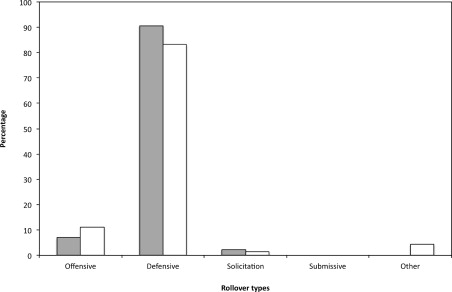Dognition polled 800 people through our social media channels, and 44% of dog parents say their dog rolls over during play with another dog. Are these dogs communicating that they are subordinate to their play partner?
A 2014 study out of University of Lethbridge and University of South Africa looked to see what a dog rolling over to a supine position during play with another dog really means. Does it communicate submission?
In the study, researchers had one dog play with 33 other dogs. They also scored 40 YouTube videos of dogs playing: 20 videos were of dogs playing with a similar size partner and the other 20 were of two dogs of different sizes playing together.
The researchers were curious if dogs are like wolves: a subordinate wolf is known to stop aggression from a dominant wolf by rolling onto his or her back in submission. The wolf will also exhibit flattened ears, curved spine, tucked tails, and an averted gaze. When submitting to another more dominant wolf, the subordinate wolf will lay on the ground in the supine position for as long as it takes to stop the aggression. As dogs come from the evolutionary lineage of wolves, does rolling over during play have a similar meaning?
It seems not.
The researchers found that dogs are more likely being strategic in play when rolling over to their backs. This position gives them an advantage: the dog gets to block bites to the nape of neck as well as go on the offensive and bite playfully at the other dog’s throat.
Dogs might also roll over after a play bow to solicit play with another dog. Bigger dogs will roll over to self-handicap in play with smaller dogs. Below is a summary graph of rollover types:

Figure from Norman et al. (2015) shows percentage of possible rollover types. Shaded columns show staged play (data set 1) and white columns show YouTube play (data set 2).
When scoring the rollover types, the researchers did not score any dog as submitting. For a rollover to be scored as an act of submission, the researchers were looking for overt aggression in the play partner and for the dog that rolled over to be in the supine position long enough to stop the play behavior or aggression of the other animal. The researchers found that play continued after a rollover occurred, and that 80-90% of rollovers were used to lunge and bite at the partner’s throat (offensive) or to avoid bites to the nape of the neck (defensive).
So it seems that dogs and wolves have diverged when it comes to what rollover behavior means. For wolves, rolling over is a means to stop aggressive behavior from a dominant wolf, and for dogs, rolling over in play is usually communicating strategic fun!
Reference:
Norman K., Pellis, S., Barrett, L., & Henzi, S. P. (2015). Down but not out: Supine postures as facilitators of play in domestic dogs, Behavioural Processes, 110 88-95.
DOI: http://dx.doi.org/10.1016/j.beproc.2014.09.001
Curious about your dog’s unique intelligence? Dognition can help! Play our science-based games now.



